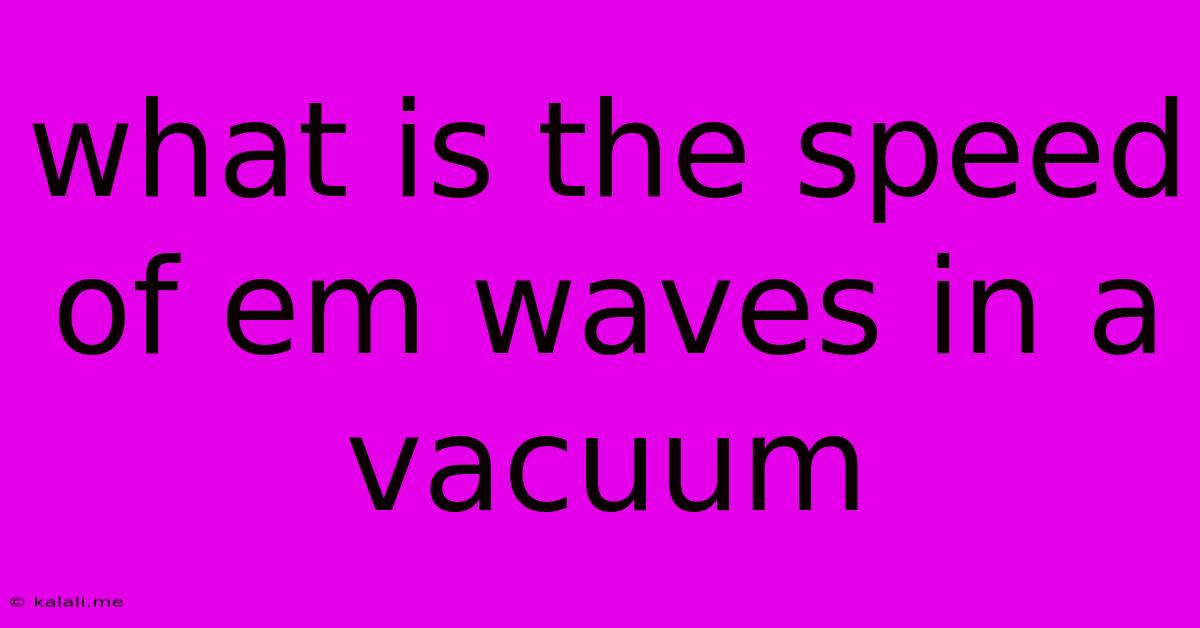What Is The Speed Of Em Waves In A Vacuum
Kalali
May 22, 2025 · 3 min read

Table of Contents
What is the Speed of EM Waves in a Vacuum? A Comprehensive Guide
The speed of electromagnetic (EM) waves in a vacuum is a fundamental constant in physics, representing a universal speed limit. This article delves into the intricacies of this speed, its significance, and its implications across various scientific fields. Understanding this constant is crucial for comprehending phenomena from radio waves to gamma rays and the very fabric of spacetime.
The Universal Constant: c
The speed of electromagnetic waves in a vacuum is denoted by the letter c, a symbol representing one of the most important constants in physics. Its value is approximately 299,792,458 meters per second (m/s). This speed is not just a measured quantity; it's a defined constant within the International System of Units (SI). The meter itself is defined in relation to c, making the speed of light in a vacuum a cornerstone of modern metrology.
Why is the Speed Constant?
The constant speed of EM waves in a vacuum is a consequence of Maxwell's equations, which describe the behavior of electric and magnetic fields. These equations predict the existence of self-propagating waves that travel at a speed determined by the permittivity and permeability of free space – fundamental properties of the vacuum. The elegance and predictive power of Maxwell's equations solidified the understanding of light as an electromagnetic wave.
Factors Affecting EM Wave Speed
While c represents the speed in a perfect vacuum, the speed of light is slower in any medium other than a perfect vacuum. The refractive index of a material describes how much slower light travels in that medium compared to its speed in a vacuum. Denser materials, with stronger interactions between light and their constituent atoms, exhibit higher refractive indices and consequently slower light speeds. This slowing is due to the interaction of photons with the charged particles within the material.
This speed reduction is crucial in many applications, influencing phenomena such as refraction (bending of light) and dispersion (separation of light into different wavelengths).
The Significance of c
The speed of light in a vacuum (c) is far more than just a number; it has profound implications across physics:
-
Special Relativity: c is the fundamental speed limit in the universe, according to Einstein's theory of special relativity. No object with mass can reach or exceed this speed. This has revolutionary consequences for our understanding of space and time, leading to concepts like time dilation and length contraction.
-
Electromagnetism: As already mentioned, c arises directly from Maxwell's equations, unifying electricity, magnetism, and light within a single theoretical framework.
-
Cosmology: c plays a crucial role in cosmological calculations, allowing us to measure vast distances in the universe and understand the expansion of the cosmos.
-
Quantum Mechanics: c appears frequently in quantum mechanics equations, highlighting the connection between the quantum world and relativistic effects.
Measuring the Speed of Light
While c is now a defined constant, its measurement has a rich history, with scientists like Rømer, Fizeau, Foucault, and Michelson contributing to progressively more accurate determinations. These experiments, employing ingenious methods involving rotating mirrors, helped refine our understanding of light's nature and speed, paving the way for modern metrology.
In conclusion, the speed of electromagnetic waves in a vacuum, c, is not merely a physical constant; it’s a fundamental pillar of modern physics, deeply interwoven with our understanding of spacetime, electromagnetism, and the universe itself. Its constant value underpins many crucial theories and applications, solidifying its significance in scientific discourse.
Latest Posts
Latest Posts
-
Why Is My Shower Water Cold But Sink Hot
May 22, 2025
-
Do Not Awaken Love Before Its Time
May 22, 2025
-
How To Divide Small Number By Large
May 22, 2025
-
Can You Drink Dublin Tap Water
May 22, 2025
-
How Many Atoms Are In A Grain Of Sand
May 22, 2025
Related Post
Thank you for visiting our website which covers about What Is The Speed Of Em Waves In A Vacuum . We hope the information provided has been useful to you. Feel free to contact us if you have any questions or need further assistance. See you next time and don't miss to bookmark.